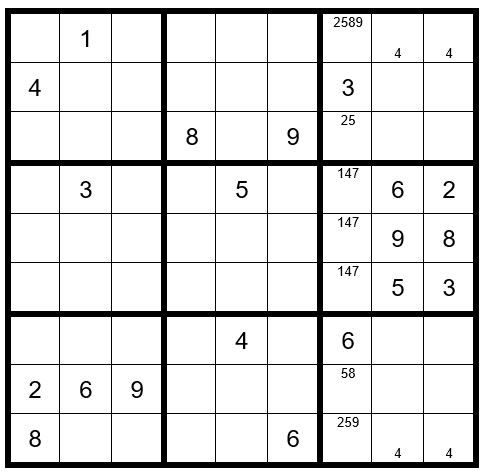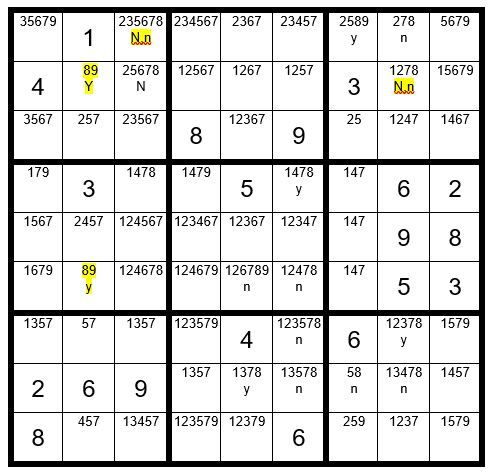Spring is around the corner. So, this month the feature puzzle should take less time, giving you more time to spend outdoors.
Clueless?
As a bonus each month this year we will start with a Sudoku puzzle in progress, where it appears there are no more obvious or not-so-obvious clues. Does this puzzle #77 have any more clues?

(The answer follows below after the conclusion of Puzzle #78, the feature puzzle for March)
The Impossible Series continues.
What techniques will be needed to solve this puzzle?
DAN’S 8-STEP APPROACH TO SOLVING ALL SUDOKU PUZZLES
Once you have completed the puzzle, to the extent that you have filled-in all obvious answers and have written all potential options across the top of the unsolved cells (PUZZLE PREPARATION), Dan recommends the following Steps to complete the puzzle.
Step 1: Sudoku Pairs, Triplets and Quads – See September 2015
Step 2: Turbos & Interaction – See October 2015
Step 3: Sudoku Gordonian Rectangles and Polygons – See November 2015
Step 4: XY-Wings & XYZ Wings – See December 2015
Step 5: X-Wings – See January 2016
Step 6: DAN’S YES/NO CHALLENGE
Step 7: DAN’S CLOSE RELATIONSHIP CHALLENGE
Step 8: AN EXPANSION OF STEP 7Steps 1-5 are relatively common techniques and are explained in the TI LIFE articles above. Steps 6-8 are covered in detail, in Dan’s book.

Puzzle #78

PUZZLE PREPARATION
Prior to utilizing techniques 1-8 first complete the 5 Steps of Puzzle Preparation …
- FILL IN DATA FROM OBSERVATIONS
- FILL IN OBVIOUS ANSWERS
- FILL IN NOT-SO-OBVIOUS ANSWERS
- MARK UNSOLVED CELLS WITH OPTIONS THAT CANNOT EXIST IN THOSE CELLS
- FILL IN THE OPTIONS FOR THE UNSOLVED CELLS
_______________________
We will complete all of the first 4 steps in the order we observe them.
We will start with the 1’s and navigate through 2’s to 9’s, then repeat the process until we conclude all Puzzle Preparation Step 1-4 clues.
The first thing we observe is that C9R6 (cell in column 9, row 6) =3 (obvious answer). Then, C8R4=6 and C2R8=6.
Now your grid should look like Example #78.1 below:

The unsolved cells in box 6 can only have 1,4 & 7 as options. Indicate this by placing a 147 at the top of those three cells. The remaining unsolved cells in column 7 can only have options 2589, so fill in the options for those cells.
In box two a 4 can only exist as an option in C4R1 or C6R1; therefore, a 4 cannot exist as an op-tion in C8R1 and C9R1. Indicate this by placing a small 4 in the bottom of those cells.
In box seven a 4 can only exist as an option in cells C2R9 or C3R9; therefore, a 4 cannot exist as an option in C8R9 or C9R9.
Now your grid should look like Example #78.2 below:

This concludes Puzzle Preparation steps 1-4. We will now fill in the options for the unsolved cells, giving us Example #78.3 below:

TECHNIQUES 1-5
Take a close look at column 2. What do you observe? There are only two unsolved cells that can the options 89, C2R2 & C2R6. This is an example of a hidden pair, so change the options for those two cells to 89.
Now your grid should look like Example #78.4 below:

There are no other Step 1-5 clues.
We will now proceed to Step 6: Dan’s Yes-No Challenge. We will start by searching the 1’s to see if there is a potential Step 6 clue, and then navigate through the 2-9’s.
There are 3 circumstances that establish the potential for a Step 6 exercise:
- Look for just 2 unsolved cells in a box that contain the same option where these 2 cells are not in the same row or column.
- Look for just 2 unsolved cells in a column that contain the same option where these 2 cells are not in the same box.
- Look for just 2 unsolved cells in a row that contain the same option where these 2 cells are not in the same box.
In Example #78.5 below we find two unsolved cells in column 2 that are not in the same box having an 8 as an option, C2R2 & C2R6 which become our “driver” cells. One of these two cells must be an 8.
We start with C2R2 and assume it is the 8 and assign a “Y”. We then mark, as before, the cells which can and cannot be an 8 with the Y’s and N’s. We then assume C2R6 is the 8 and assign a “y”. We then mark the cells which can and cannot be an 8 with the y’s and n’s. Where we see a N,n indicates a cell that cannot be an 8 regardless of whether C2R2 or C2R6 is the 8 in column two.

We can remove the 8 from C3R1 and C8R2. Now your grid should look like Example #78.6 below:

In Example #78.6 above we find two unsolved cells in column 2 that are not in the same box having a 9 as an option, C2R2 & C2R6 which become our “driver” cells. One of these two cells must be a 9. Track the yes’s and no’s like the last example and you observe that C1R1 and C9R2 cannot be a 9, and you may remove the 9 as an option for those two cells.
Now your grid should look like Example #78.7 below:

What do you observe in box 1? The only cell that can be a 9 is C2R2. It then follows that C2R6=8. C6R4=8. C5R8=8. From this point the puzzle is easily solved, giving us the final version in Example #78.8 below:

Hopefully by this point you have a good working knowledge of Step 6.
May the gentle winds of Sudoku be at your back.
Dan LeKander
Clue for Puzzle #77 … focus your attention to column 7. What do you observe?
There are only two cells in column 7 that can have options 34, C7R2 & C7R7. Enter those options in your grid. Now, the only cell in column 7 that can be a 6 is C7R9. It then follows that C2R8=6, C3R6=6, C5R6=2, C5R5=4, C5R1=6, C8R2=6 and so forth.
Posted in: Volume 16, Issue 3, March 2021, Sports
Please click here if you are unable to post your comment.
